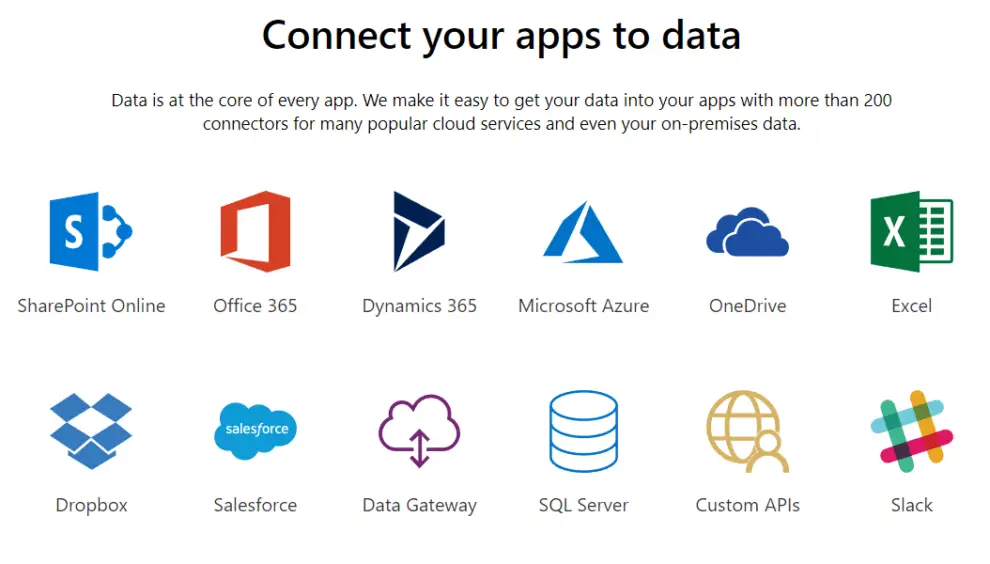Microsoft PowerApps is a tool that simplifies the process of creating custom applications and solutions for organizations. Sometimes, organizations encounter unique needs that can’t be solved by existing applications.
This is where Microsoft PowerApps comes in to bridge these gaps by allowing organizations to create applications suited to the need at hand. What sets Microsoft PowerApps apart is how simple it is to use. There is no need for a programming background or coding knowledge. One can either use a model-driven app that provides a basis for the business process or use canvas to design their application from scratch.
Microsoft PowerApps’ versatility brings to life any imaginable business solution. Now that we know what Microsoft PowerApps is, let’s look at how it integrates with Office 365.
Understanding Office 365
Office 365 is Microsoft’s platform that brings together all the productivity tools needed in an organization.
A licensed Office 365 software has all the Microsoft office tools including Excel, Word, PowerPoint, Access, Publisher, SharePoint, and Outlook. Users also get access to OneDrive, a cloud storage facility from Microsoft.
Office 365 allows teams to access and manipulate information from multiple devices at the same time. This makes it easier to collaborate on projects regardless of where staff members are located.
Create an App for Office 365 using Microsoft PowerApps
As we said, there are two ways through which you create your custom app using the PowerApps for Office 365 suite by Microsoft.
Model-driven apps
With this option, you will use existing templates to create an app. All you have to do is integrate whatever data into these templates to design your app. Since there is an existing infrastructure, it’s quicker to model apps on this option.
Canvas model apps
This option offers more freedom for creativity. It allows you to create an app from the ground based on your ideas and imagination.
Your team can use both options to create apps based on data stored in a SharePoint, or brainstorm and design an app from scratch.
You can use PowerApps to create and edit system charts, dashboards, and views or add business logic in Office 365.
Create AIs
A lot of businesses are now turning to AI to address their needs and for a very good reason. AI works for you even when you aren’t working and ensures your business runs without interference.
You can easily create AI models on PowerApps using pre-built templates. The pre-built templates guide you on how to build, train and publish your AI models.
AI can be applied in Office 365 to classify data, create predictions, detect objects, and perform so many other tasks.
Automate Processes with PowerApps for Office 365
Process automation is one of the surest ways of increasing efficiency. Luckily, PowerApps allows users to automate business processes.
For instance, you can set up PowerApps to automatically share information collected from AI models with concerned departments for prompt action.
The best part yet is that you can create automation processes that link over 200 sources. This ensures your team’s productivity stays high at all times.
Build Secure Portals
Some businesses are now outsourcing specific services or entire departments to create leaner business processes. In such instances, it means sharing crucial data with parties that do not necessarily abide by that organization’s culture.
This possesses a major risk for your business and stakeholders. The good news is that PowerApps alleviates this risk by enabling you to grant specific data access to specific groups.
With the PowerApps portal, you can choose which data to share internally or externally. All you need is to create this authentication requirement anonymously or contract a commercial authentication provider.
Connect Data
Common Data Service is a powerful service in PowerApps that brings on-premise and cloud data together. This scalable service allows you to do more than just link data.
You can set ground rules for data validation using business process flows, or establish a reliable source for authentic data for everyone. This helps solve the perennial problem of data connectivity facing most businesses.
PowerApps also makes it easy for your business to consume big data by breaking up data silos. For instance, your organization’s marketing department might have data needed by the sales department but lack a means of effectively sharing the data.
Conclusion
PowerApps has the potential to turn your business fortunes around. One way to do it is by taking advantage of its tools and services to streamline Office 365 functions.
For example, you can create apps to enhance the functions of existing Office 365 tools. PowerApps Common Data Service, AI capability, and Automation services can integrate with Office 365 to enhance your business processes.
In addition to these collaborative features, Office 365 provides opportunities to enhance data analysis and reporting capabilities. With the integration of tools like Power BI paginated report builder, teams can take their data visualization and reporting to the next level. Power BI paginated report builder enables users to create sophisticated, pixel-perfect reports that are tailored for printing or generating electronic documents. This functionality complements the collaborative nature of Office 365 by allowing teams to communicate insights and data-driven findings effectively. With that said, it would be a good idea to get your employees to take Microsoft Office training to get the most out of the software.








